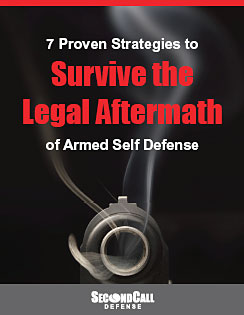Handgun Self-Defense: Move to Stay Alive
by W.H. “Chip” Gross
If you ever become involved in a self-defense situation, it will likely occur suddenly, unexpectedly, and could turn very violent very quickly. And if you feel threatened to the point that you choose to draw your concealed handgun, remember that it’s now a gunfight, not target shooting.
Your goal is to win and survive any way you can. Because reaction is always slower than action, you will be slightly behind the curve. But you can counter that disadvantage through movement. By moving while shooting you are doing something the aggressor did not expect, so now he/she must react to you. In short, movement could save your life.
But to become proficient at this technique, you must incorporate movement into your regular handgun training. Unfortunately, most public ranges don’t allow this type of advanced practice. If you were to try running while shooting, as well as reloading a handgun on the run at a public range, you’d see how quickly you were asked to leave. (NB: Please don’t do that.)
Which is why I sought out the Move or Die advanced-handgun training course conducted recently by the Buckeye Firearms Association at the EAST Group range in north-central Ohio. Usually available only to police officers and military personnel, EAST Group opens its outdoor ranges half a dozen times per year to the public. Its owner and head instructor (“Sly”) is more than qualified to teach such instruction. A retired U. S. Marine Corps “gunny” turned personal protective specialist, you can check out his background by clicking on a previous NRA Family story here.
The day began with a half-hour classroom session. “The ultimate goal for the next eight hours is for you to learn to perceive and react to a threat in a timely manner—just 1.5 seconds,” Sly began. “In other words, to move off what is called the ‘X’ quickly and aggressively. Because if you don’t move, the ‘X’ is where you are going to die during a gunfight.”
Sly next explained the Combat Triad. “Think of it as the three points of a triangle: mindset, gun manipulation and marksmanship,” he said. “The proper mindset involves being ready and willing to do whatever you have to do to survive a gunfight. Gun manipulation, also known as ‘running the gun,’ is being so familiar with your handgun that shooting and reloading are automatic; you don’t have to consciously think about what you are doing. And marksmanship is simply hitting what you aim at. Because a threatening situation is not likely to change unless and until you are able to put hits on the target.”
Once to the range, live firing for the day began with a 40-round assessment drill. The three instructors (a woman, Candy, and another guy, Jeff, in addition to Sly) worked with the 19 students, about a third of whom were women. Students ranged in age from their 20s to a few folks in their 60s or even 70s.
Next came the movement drills, which is about learning to react to a situation quickly, then pivot and run laterally, right or left. “Don’t move backwards from a threat, for two reasons,” said Sly. “First, moving backwards still keeps you directly in line with the threat. And second, by backpedaling it’s more likely you will catch your heel on something and fall backwards. Then you’re really screwed. Instead, make your first move right or left and seek cover.”
Sly added that a self-defender should remember to aim at center mass, which translates to the torso of the threat. “As human beings, we are hardwired to look each other in the eye,” he said. “But during a gunfight that’s counterproductive because your shots will likely go where you are looking…the head is a much smaller target than the torso, so look and aim there.”
Following a break for lunch, the afternoon range session was a series of various drills teaching students to anticipate a threat, draw our handguns, and fire several shots while running laterally to cover. “You should be drawing your sidearm as you begin moving,” Sly often repeated. “Don’t move and then draw, that’s too late. And if for some reason you can’t get your gun out of the holster, which sometimes happens during high-stress situations, especially if you are wearing a cover garment, don’t stop to do so, keep moving. The same for reloading, if your gun runs dry, reload on the move, don’t stop. Stopping gets you killed.”
As you may have already surmised, the one-day course was intense training, the instructors attempting to put the students under pressure to simulate the stress of a gunfight as much as possible. Upon returning to the classroom for a final debriefing session, the consensus of the participants was that it had been an excellent day of instruction at an excellent facility, and that they would highly recommend the training to other concealed-carry holders.
Sly summed up the training with this last sobering bit of advice. “Continue practicing what you learned by incorporating movement into your handgun training. Learn to quickly assess a potentially dangerous situation, and then if it does hit the fan, move and shoot your way out of it.”
“

